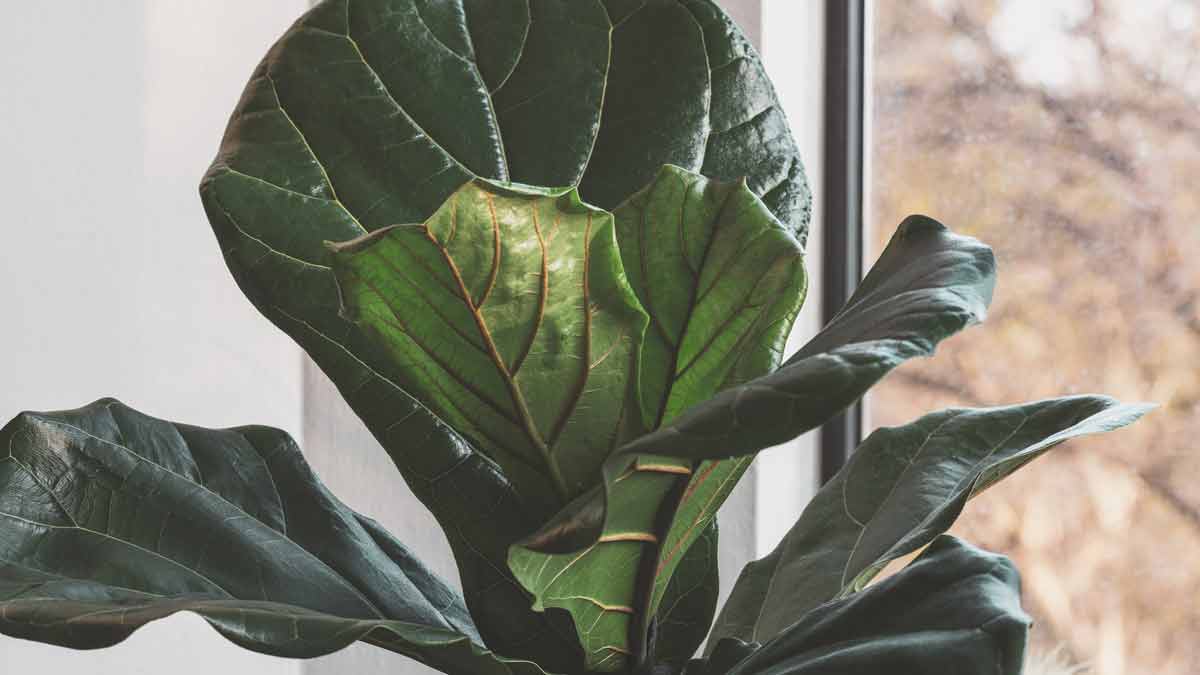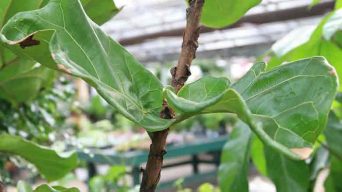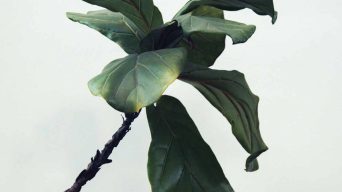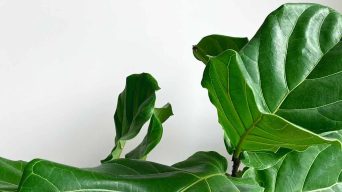Root rot is caused by a fungus that thrives in moist soil and can damage the roots of your fiddle leaf fig. It is usually a result of overwatering or poorly draining soil, which creates an environment for the fungus to grow. Root rot symptoms include yellowing leaves, wilting or drooping, and brown or black spots on the leaves.
Fiddle leaf figs (Ficus lyrata) are a beautiful, popular houseplant. They are known for their large, glossy leaves ranging from deep green to purple.
While fiddle leaf fig plants are relatively easy to care for, they are susceptible to a few problems, one of which is root rot.
In this article you’ll find everything you need to know about root rot in fiddle leaf figs, how to prevent it, and how to save your plant if it becomes affected.
What is Root Rot?
Root rot is a condition that can affect many types of plants, including fiddle leaf figs.
It is caused by fungi or bacteria that attack the root system of the plant, causing them to rot.
A fiddle leaf fig plant with root rot cannot absorb water or nutrients from the soil, leading to wilting, yellowing leaves, and eventually death.
In fiddle leaf figs, root rot is often caused by too much moisture in the soil.
The plant’s roots are very sensitive and can be easily damaged by overwatering.
If you think your fiddle leaf fig has root rot, there are a few things you can do to save it.
What Causes Rotting Roots?
There are several reasons your fiddle leaf fig tree may have root rot.
The most common reasons are:
Overwatering
Overwatering is the number one cause of root rot in fiddle leaf figs.
When you overwater your plant, the roots cannot receive the oxygen they need and suffocate. The lack of oxygen leads to root rot.
Overwatering fiddle leaf fig plants is a common problem because many believe more water is always better. However, excessive water can be lethal for your plant.
Using a moisture meter is a great way to ensure that your plants are receiving the right amount of water.
It helps measure the moisture in the soil and alerts you if the soil is too wet or too dry, allowing you to adjust your watering accordingly and avoid potential issues caused by over- or under-watering.
Poor Drainage
If your pot doesn’t have good drainage, the roots will sit in water and start to rot.
Make sure you have a pot with holes in the bottom to drain the water.
You can also add gravel or rocks to the bottom of the pot to help with drainage.
A well-draining soil mix is also essential. If the soil is too dense, it will hold onto water and not allow the roots to dry.
A light, airy potting mix is best for your fiddle leaf fig.
Compact Soil
If the soil is too compacted, it can also cause problems with drainage.
The roots may not be able to get the oxygen they need and start to rot.
You can tell if the soil is too compacted if it feels dense and heavy.
Ensure you loosen the soil around your plant every few months to prevent this.
Root Damage
If the roots are damaged, they may start to rot.
This can happen if you move your plant too often or repot it without being careful.
Damaged roots are more susceptible to infections, so it’s essential to be gentle with your plant.
Fungal Infections
Fungal infections are one of the most common problems affecting a fiddle leaf fig.
When the humidity levels are too high, it creates an ideal environment for fungi to grow and spread, leading to mildew on the plants and, ultimately, rotting of the roots if left unchecked.
Mildew is a type of fungus that thrives in warm, moist environments, making it a common problem in greenhouses. It appears as a white or grayish-white powdery coating on the surface of the leaves and stems and can spread quickly throughout the entire plant.
It is a fungal disease that is caused by a variety of fungi, including Alternaria, Cladosporium, and Fusarium. The fungus will penetrate the plant’s cells and cause them to die, resulting in wilting, discoloration, and root rot.
What Does Rotting Roots Look Like?
There are a few signs that you can look for to see if your fiddle leaf fig has root rot.
These include:
Drooping Leaves
If the leaves on your fiddle leaf fig are drooping, this is one of the first signs that something is wrong. This happens because the roots cannot take up enough water to support the plant.
If you see this happening, it’s essential to check your plant’s roots.
Yellowing Leaves
Yellowing leaves are another sign that something is wrong with your plant. This happens when the roots cannot take up nutrients from the soil.
The leaves will turn yellow and brown as the problem worsens.
Black or Brown Spots on the Leaves
Brown or black spots on the fiddle leaf fig leaves can be a sign of root rot or fungal infection.
The spots usually start small but gradually get bigger as the problem progresses.
The leaves may also start to turn yellow or brown around the edges.
Soft or Mushy Roots
If you notice that your plant’s roots are soft or mushy, this is a sure sign that they are rotting.
Healthy roots are firm and white or cream-colored.
If you see any soft, mushy, or discolored roots, this is a sign that they are starting to rot.
Bad Smell
If your plant has root rot, you may notice a bad smell coming from the pot.
The smell is usually caused by the fungi growing on the roots.
The putrid odor emanating from the pot was a tell-tale sign of the fungi growing on the roots, leaving an unpleasant smell that was difficult to ignore.
If you notice a bad smell, it’s essential to check the roots of your plant to see if they are starting to rot.
Stunted Growth
If your plant is not growing as quickly as it should be, this can be a sign of root rot.
The roots are responsible for taking up water and nutrients from the soil, so if they rot, the plant will not be able to get the resources it needs to grow.
Wilting Leaves
If the leaves of your plant start to wilt, this is a sign that the roots cannot take up enough water.
If you see this happening, it’s essential to check the roots of your plant to see if they are starting to rot.
Dieback
Dieback is another sign that your plant’s roots cannot absorb water and nutrients.
The leaves will turn yellow or brown, and the roots will die from the tips. This is a serious problem; if you see it happening, you should check the roots of your plant to see if they are starting to rot.
How To Treat Root Rot On Fiddle Leaf Fig Plants
If you think your plant has root rot, it’s essential to take action immediately.
Root rot can quickly kill a plant if it is not treated, so it’s essential to be vigilant. The sooner you catch the problem, the easier it will be to treat.
Here is a step-by-step guide to treating fiddle leaf fig root rot:
1. Remove the Plant From the Pot
The first step is to remove the plant from the pot or container.
Be careful, and avoid damaging the roots as you do this.
Gently grasp the base of the plant and carefully slide it out of the pot, taking care to keep the root ball intact as you do so.
If the plant is rootbound, you may need to cut some roots away to free it from the pot.
2. Inspect the Roots
Once the plant is out of the pot, inspect the roots.
Look for any that are soft, mushy, or discolored.
You can tell if the roots are healthy if they are white or cream-colored.
If you see any that are not, those are the ones you will need to focus on.
3. Clean the Roots
The next step is to clean the roots.
You can do this by gently brushing away any dirt or debris.
You can also rinse the roots with water to remove any remaining dirt.
After brushing away any dirt or debris and rinsing the roots with water to remove any remaining dirt, you can use hydrogen peroxide to sanitize the roots further.
Soak them in a solution of one part hydrogen peroxide to four parts water for a few minutes.
4. Remove the Affected Roots
Once you have cleaned the roots, it’s time to remove the affected ones.
Cut away any roots that are soft, mushy, or discolored.
Cut well below the affected area to remove all the rot.
Using a pair of scissors or pruning shears, carefully cut away the affected roots from the plant, making sure to remove any roots that are attached to the rot, and discard them properly.
5. Treat the Roots With Fungicide
After you have removed the affected roots, you need to treat the remaining ones with a fungicide.
Pathogens, such as fungi, can cause root rot and other diseases in plants, so using a fungicide to kill off any existing pathogens and prevent the spread of root rot is an important step in protecting your plants from disease.
6. Discard the Soil and Replace it With Fresh Soil
The next step is to discard the old soil and replace it with fresh soil.
This is important because the old soil may be contaminated with fungi that can cause root rot.
Be sure to use a well-draining potting mix to help prevent the problem from recurring.
7. Wash the Pot
After you have replaced the soil, be sure to wash the pot with soap and water.
This will help to remove any remaining fungi that could cause root rot.
Ensure the pot is completely dry before replanting your fiddle leaf fig.
8. Repot Your Plant
The final step is to repot your plant.
Make sure to use fresh soil and a well-draining pot.
Once you have repotted your plant, closely monitor its recovery to ensure it adjusts to its new environment and soil.
Ensure it receives the proper nutrients and water it needs to thrive.
How To Prevent Fiddle Leaf Fig Root Rot
The best way to prevent root rot is to be proactive.
Here are some tips to help you prevent root rot on fiddle leaf fig plants:
Use a Well-Draining Soil
One of the most important things you can do to prevent root rot is to use a well-draining potting soil mix.
Some potting mixes are specifically designed to provide good drainage, while others are not.
To ensure that your potting mix is well-draining, you can add perlite or sand to it. This will help the soil to hold less water and allow excess water to drain away, which is essential for healthy plant growth.
The addition of perlite or sand can also help to improve aeration, which is important for the roots of the plants to be able to access oxygen and nutrients.
This will help to prevent the roots from sitting in water, which can lead to rot.
Allow the Soil to Dry Out Between Waterings
It’s also essential to allow the soil to dry out between waterings.
This will let the roots breathe and help prevent them from sitting in water.
Avoid Overwatering
Overwatering is one of the biggest mistakes people make when caring for a fiddle leaf fig.
It’s important to remember that these plants are native to dry climates and can’t handle too much water.
Be sure to check the soil before watering and only water when the soil is dry.
Use Pots With Drainage Holes
Another essential thing to remember is to use pots with drainage holes.
This will allow any excess water to drain out of the pot and help prevent the roots from sitting in water.
You can also add a layer of gravel to the bottom of the pot to help with drainage.
Repot in New Soil Every One to Two Years
It’s also a good idea to repot your fiddle leaf fig in new potting soil every one to two years.
This will help to prevent the build-up of fungi and will also help to keep the plant healthy.
Place Your Plant in a Bright Indirect Light
It’s essential to place your fiddle leaf fig tree in bright, indirect sunlight. This will help prevent the growth of fungi and promote optimal growth.
The sun’s rays offer a perfect balance of direct and indirect light, enabling the plant to absorb necessary nutrients and energy for growth and thriving, all while deterring the growth of fungi and other harmful organisms.
Insufficient light can stress the plant, making it more susceptible to root rot.
Provide Good Air Circulation
It’s also essential to provide good air circulation.
This will help to prevent the growth of fungi and will also help to keep the fiddle leaf fig plant healthy.
Place your plant in a location where it will get some airflow, and be sure to keep the fiddle leaf fig leaves clean.
Prune Dead or Dying Leaves
Be sure to prune any dead or dying leaves from the plant.
This will help to prevent the spread of fungi and will also help to keep the plant healthy.
Inspect Your Plant Regularly
It’s also a good idea to inspect your plant regularly.
This will help you to catch any problems early and will also help you to prevent the spread of fungi.
Isolate Sick Plants
If you spot a sick plant, it’s important to immediately isolate it from other plants to prevent the spread of any potential fungal diseases and to ensure that the sick plant receives the proper care and attention it needs to get back to health.
This will help to prevent the spread of disease and will also help to keep your other plants healthy.
These are just a few tips to help you prevent root rot on your fiddle leaf fig.
If you follow these tips, you should be able to keep your plant healthy and free from disease.
Final Thoughts
Fiddle leaf fig plant care can be challenging, but the joy of seeing your plant thrive makes it all worthwhile.
Plant owners should be well-informed about the specific needs of their fiddle leaf fig plants. The plant’s health is closely tied to its environment, making it crucial to ensure it’s in the right location.
If you notice your fiddle leaf fig plant isn’t thriving, it’s essential to swiftly identify the cause of its distress and take necessary steps to remedy the situation. This can include providing adequate light, water, and nutrients, as well as ensuring suitable temperature and humidity levels for the plant.
The lush foliage of a healthy Fiddle leaf fig is truly a sight to behold. With proper care and attention, you can ensure that your plant’s leaves stay vibrant and robust, adding a beautiful green touch to your home decor.
Houseplants offer an easy and affordable way to add a burst of color to any home. With appropriate care and maintenance, they can help keep your home looking beautiful and vibrant, providing lush green foliage that will remain strong and healthy for years to come.







